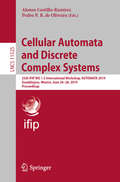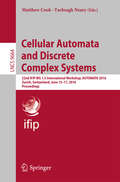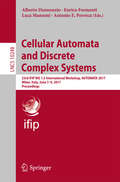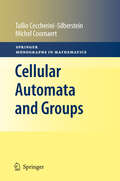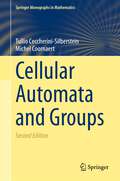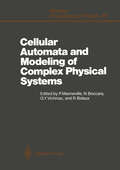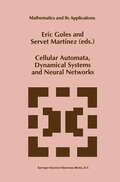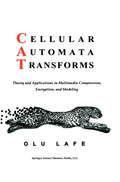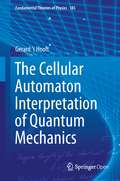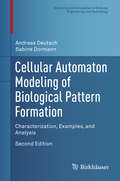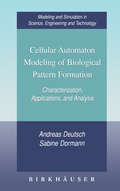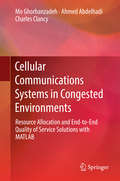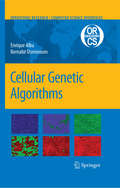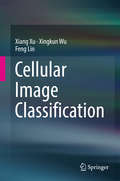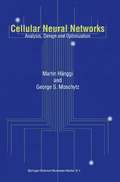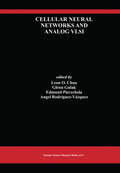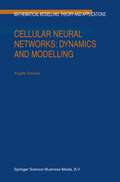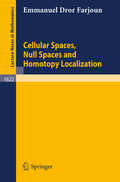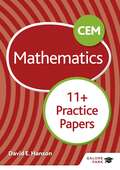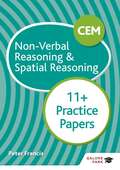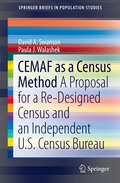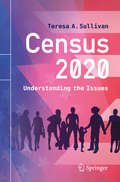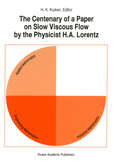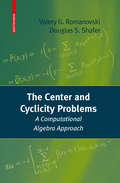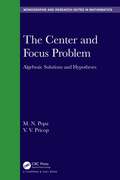- Table View
- List View
Cellular Automata and Discrete Complex Systems: 25th IFIP WG 1.5 International Workshop, AUTOMATA 2019, Guadalajara, Mexico, June 26–28, 2019, Proceedings (Lecture Notes in Computer Science #11525)
by Alonso Castillo-Ramirez Pedro P. B. de OliveiraThis volume constitutes the refereed proceedings of the 25th IFIP WG 1.5 International Workshop on Cellular Automata and Discrete Complex Systems, AUTOMATA 2019, held in Guadalajara, Mexico, in June 2019.The 7 regular papers presented in this book were carefully reviewed and selected from a total of 10 submissions. The topics of the conference include deal with dynamical, topological, ergodic and algebraic aspects of CA and DCS, algorithmic and complexity issues, emergent properties, formal languages, symbolic dynamics, tilings, models of parallelism and distributed systems, timing schemes, synchronous versus asynchronous models, phenomenological descriptions, scientic modeling, and practical applications.
Cellular Automata and Discrete Complex Systems: 22nd IFIP WG 1.5 International Workshop, AUTOMATA 2016, Zurich, Switzerland, June 15-17, 2016, Proceedings (Lecture Notes in Computer Science #9664)
by Matthew Cook Turlough NearyThis volume constitutes the thoroughly refereed proceedings of the 22nd IFIP WG 1.5International Workshop on Cellular Automata and Discrete ComplexSystems, AUTOMATA 2016, held in Zurich, Switzerland, in June 2016.This volume contains 3 invited talks in full-paper length and 12 regularpapers, which were carefully reviewed and selected from a total of 23submissions. The papers feature research on all fundamental aspects of cellular automata and related discrete complex systems and deal with the following topics: dynamical, topological, ergodic and algebraic aspects; algorithmic and complexity issues; emergent properties; formal language processing; symbolic dynamics; models of parallelism and distributed systems; timing schemes; phenomenological descriptions; scientific modeling; and practical applications.
Cellular Automata and Discrete Complex Systems: 23rd IFIP WG 1.5 International Workshop, AUTOMATA 2017, Milan, Italy, June 7-9, 2017, Proceedings (Lecture Notes in Computer Science #10248)
by Alberto Dennunzio Enrico Formenti Luca Manzoni Antonio E. PorrecaThis volume constitutes the thoroughly refereed proceedings of the 23rd IFIP WG 1.5 International Workshop on Cellular Automata and Discrete Complex Systems, AUTOMATA 2017, held in Milan, Italy, in June 2017. The 14 full papers presented together with one full-length invited paper and 2 invited talk abstracts were carefully reviewed and selected from a total of 28 submissions. The papers feature research on correlated models of automata. The topics include aspects and features of such models: dynamics; topological, ergodic, and algebraic aspects; algorithmic and complexity issues; emergent properties; formal languages; symbolic dynamics; tilings; models of parallelism and distributed systems; timing schemes; synchronous versus asynchronous models; phenomenological descriptions; scientific modelling; practical applications.
Cellular Automata and Groups (Springer Monographs in Mathematics)
by Tullio Ceccherini-Silberstein Michel CoornaertCellular automata were introduced in the first half of the last century by John von Neumann who used them as theoretical models for self-reproducing machines. The authors present a self-contained exposition of the theory of cellular automata on groups and explore its deep connections with recent developments in geometric group theory, symbolic dynamics, and other branches of mathematics and theoretical computer science. The topics treated include in particular the Garden of Eden theorem for amenable groups, and the Gromov-Weiss surjunctivity theorem as well as the solution of the Kaplansky conjecture on the stable finiteness of group rings for sofic groups. The volume is entirely self-contained, with 10 appendices and more than 300 exercises, and appeals to a large audience including specialists as well as newcomers in the field. It provides a comprehensive account of recent progress in the theory of cellular automata based on the interplay between amenability, geometric and combinatorial group theory, symbolic dynamics and the algebraic theory of group rings which are treated here for the first time in book form.
Cellular Automata and Groups (Springer Monographs in Mathematics)
by Tullio Ceccherini-Silberstein Michel CoornaertThis unique book provides a self-contained exposition of the theory of cellular automata on groups and explores its deep connections with recent developments in geometric and combinatorial group theory, amenability, symbolic dynamics, the algebraic theory of group rings, and other branches of mathematics and theoretical computer science. The topics treated include the Garden of Eden theorem for amenable groups, the Gromov–Weiss surjunctivity theorem, and the solution of the Kaplansky conjecture on the stable finiteness of group rings for sofic groups. Entirely self-contained and now in its second edition, the volume includes 10 appendices and more than 600 exercises, the solutions of which are presented in the companion book Exercises in Cellular Automata and Groups (2023) by the same authors. It will appeal to a large audience, including specialists and newcomers to the field.
Cellular Automata and Modeling of Complex Physical Systems: Proceedings of the Winter School, Les Houches, France, February 21–28, 1989 (Springer Proceedings in Physics #46)
by Paul Manneville Nino Boccara Gerard Y. Vichniac Roger BidauxCellular automata are fully discrete dynamical systems with dynamical variables defined at the nodes of a lattice and taking values in a finite set. Application of a local transition rule at each lattice site generates the dynamics. The interpretation of systems with a large number of degrees of freedom in terms of lattice gases has received considerable attention recently due to the many applications of this approach, e.g. for simulating fluid flows under nearly realistic conditions, for modeling complex microscopic natural phenomena such as diffusion-reaction or catalysis, and for analysis of pattern-forming systems. The discussion in this book covers aspects of cellular automata theory related to general problems of information theory and statistical physics, lattice gas theory, direct applications, problems arising in the modeling of microscopic physical processes, complex macroscopic behavior (mostly in connection with turbulence), and the design of special-purpose computers.
Cellular Automata, Dynamical Systems and Neural Networks (Mathematics and Its Applications #282)
by E. Goles Servet MartínezThis book contains the courses given at the Third School on Statistical Physics and Cooperative Systems held at Santiago, Chile, from 14th to 18th December 1992. The main idea of this periodic school was to bring together scientists work with recent trends in Statistical Physics. More precisely ing on subjects related related with non linear phenomena, dynamical systems, ergodic theory, cellular au tomata, symbolic dynamics, large deviation theory and neural networks. Scientists working in these subjects come from several areas: mathematics, biology, physics, computer science, electrical engineering and artificial intelligence. Recently, a very important cross-fertilization has taken place with regard to the aforesaid scientific and technological disciplines, so as to give a new approach to the research whose common core remains in statistical physics. Each contribution is devoted to one or more of the previous subjects. In most cases they are structured as surveys, presenting at the same time an original point of view about the topic and showing mostly new results. The expository text of Fran
Cellular Automata Transforms: Theory and Applications in Multimedia Compression, Encryption, and Modeling (Multimedia Systems and Applications #16)
by Olurinde LafeCellular Automata Transforms describes a new approach to using the dynamical system, popularly known as cellular automata (CA), as a tool for conducting transforms on data. Cellular automata have generated a great deal of interest since the early 1960s when John Conway created the `Game of Life'. This book takes a more serious look at CA by describing methods by which information building blocks, called basis functions (or bases), can be generated from the evolving states. These information blocks can then be used to construct any data. A typical dynamical system such as CA tend to involve an infinite possibilities of rules that define the inherent elements, neighborhood size, shape, number of states, and modes of association, etc. To be able to build these building blocks an elegant method had to be developed to address a large subset of these rules. A new formula, which allows for the definition a large subset of possible rules, is described in the book. The robustness of this formula allows searching of the CA rule space in order to develop applications for multimedia compression, data encryption and process modeling. Cellular Automata Transforms is divided into two parts. In Part I the fundamentals of cellular automata, including the history and traditional applications are outlined. The challenges faced in using CA to solve practical problems are described. The basic theory behind Cellular Automata Transforms (CAT) is developed in this part of the book. Techniques by which the evolving states of a cellular automaton can be converted into information building blocks are taught. The methods (including fast convolutions) by which forward and inverse transforms of any data can be achieved are also presented. Part II contains a description of applications of CAT. Chapter 4 describes digital image compression, audio compression and synthetic audio generation, three approaches for compressing video data. Chapter 5 contains both symmetric and public-key implementation of CAT encryption. Possible methods of attack are also outlined. Chapter 6 looks at process modeling by solving differential and integral equations. Examples are drawn from physics and fluid dynamics.
The Cellular Automaton Interpretation of Quantum Mechanics (Fundamental Theories of Physics #185)
by Gerard 't HooftThis book presents the deterministic view of quantum mechanics developed by Nobel Laureate Gerard 't Hooft.Dissatisfied with the uncomfortable gaps in the way conventional quantum mechanics meshes with the classical world, 't Hooft has revived the old hidden variable ideas, but now in a much more systematic way than usual. In this, quantum mechanics is viewed as a tool rather than a theory.The author gives examples of models that are classical in essence, but can be analysed by the use of quantum techniques, and argues that even the Standard Model, together with gravitational interactions, might be viewed as a quantum mechanical approach to analysing a system that could be classical at its core. He shows how this approach, even though it is based on hidden variables, can be plausibly reconciled with Bell's theorem, and how the usual objections voiced against the idea of ‘superdeterminism' can be overcome, at least in principle. This framework elegantly explains - and automatically cures - the problems of the wave function collapse and the measurement problem. Even the existence of an “arrow of time" can perhaps be explained in a more elegant way than usual. As well as reviewing the author’s earlier work in the field, the book also contains many new observations and calculations. It provides stimulating reading for all physicists working on the foundations of quantum theory.
Cellular Automaton Modeling of Biological Pattern Formation: Characterization, Examples, and Analysis (Modeling and Simulation in Science, Engineering and Technology)
by Andreas Deutsch Sabine DormannThis text explores the use of cellular automata in modeling pattern formation in biological systems. It describes several mathematical modeling approaches utilizing cellular automata that can be used to study the dynamics of interacting cell systems both in simulation and in practice. New in this edition are chapters covering cell migration, tissue development, and cancer dynamics, as well as updated references and new research topic suggestions that reflect the rapid development of the field.The book begins with an introduction to pattern-forming principles in biology and the various mathematical modeling techniques that can be used to analyze them. Cellular automaton models are then discussed in detail for different types of cellular processes and interactions, including random movement, cell migration, adhesive cell interaction, alignment and cellular swarming, growth processes, pigment cell pattern formation, tissue development, tumor growth and invasion, and Turing-type patterns and excitable media. In the final chapter, the authors critically discuss possibilities and limitations of the cellular automaton approach in modeling various biological applications, along with future research directions. Suggestions for research projects are provided throughout the book to encourage additional engagement with the material, and an accompanying simulator is available for readers to perform their own simulations on several of the models covered in the text. QR codes are included within the text for easy access to the simulator.With its accessible presentation and interdisciplinary approach, Cellular Automaton Modeling of Biological Pattern Formation is suitable for graduate and advanced undergraduate students in mathematical biology, biological modeling, and biological computing. It will also be a valuable resource for researchers and practitioners in applied mathematics, mathematical biology, computational physics, bioengineering, and computer science. PRAISE FOR THE FIRST EDITION“An ideal guide for someone with a mathematical or physical background to start exploring biological modelling. Importantly, it will also serve as an excellent guide for experienced modellers to innovate and improve their methodologies for analysing simulation results.” —Mathematical Reviews
Cellular Automaton Modeling of Biological Pattern Formation: Characterization, Applications, and Analysis (Modeling and Simulation in Science, Engineering and Technology)
by Andreas Deutsch Sabine DormannThis book focuses on a challenging application field of cellular automata: pattern formation in biological systems, such as the growth of microorganisms, dynamics of cellular tissue and tumors, and formation of pigment cell patterns. These phenomena, resulting from complex cellular interactions, cannot be deduced solely from experimental analysis, but can be more easily examined using mathematical models, in particular, cellular automaton models. While there are various books treating cellular automaton modeling, this interdisciplinary work is the first one covering biological applications. The book is aimed at researchers, practitioners, and students in applied mathematics, mathematical biology, computational physics, bioengineering, and computer science interested in a cellular automaton approach to biological modeling.
Cellular Communications Systems in Congested Environments: Resource Allocation and End-to-End Quality of Service Solutions with MATLAB
by Mo Ghorbanzadeh Ahmed Abdelhadi Charles ClancyThis book presents a mathematical treatment of the radio resource allocation of modern cellular communications systems in contested environments. It focuses on fulfilling the quality of service requirements of the living applications on the user devices, which leverage the cellular system, and with attention to elevating the users’ quality of experience. The authors also address the congestion of the spectrum by allowing sharing with the band incumbents while providing with a quality-of-service-minded resource allocation in the network. The content is of particular interest to telecommunications scheduler experts in industry, communications applications academia, and graduate students whose paramount research deals with resource allocation and quality of service.
Cellular Genetic Algorithms (Operations Research/Computer Science Interfaces Series #42)
by Enrique Alba Bernabe DorronsoroCellular Genetic Algorithms defines a new class of optimization algorithms based on the concepts of structured populations and Genetic Algorithms (GAs). The authors explain and demonstrate the validity of these cellular genetic algorithms throughout the book with equal and parallel emphasis on both theory and practice. This book is a key source for studying and designing cellular GAs, as well as a self-contained primary reference book for these algorithms.
Cellular Image Classification
by Xiang Xu Xingkun Wu Feng LinThis book introduces new techniques for cellular image feature extraction, pattern recognition and classification. The authors use the antinuclear antibodies (ANAs) in patient serum as the subjects and the Indirect Immunofluorescence (IIF) technique as the imaging protocol to illustrate the applications of the described methods. Throughout the book, the authors provide evaluations for the proposed methods on two publicly available human epithelial (HEp-2) cell datasets: ICPR2012 dataset from the ICPR'12 HEp-2 cell classification contest and ICIP2013 training dataset from the ICIP'13 Competition on cells classification by fluorescent image analysis. First, the reading of imaging results is significantly influenced by one’s qualification and reading systems, causing high intra- and inter-laboratory variance. The authors present a low-order LP21 fiber mode for optical single cell manipulation and imaging staining patterns of HEp-2 cells. A focused four-lobed mode distribution is stable and effective in optical tweezer applications, including selective cell pick-up, pairing, grouping or separation, as well as rotation of cell dimers and clusters. Both translational dragging force and rotational torque in the experiments are in good accordance with the theoretical model. With a simple all-fiber configuration, and low peak irradiation to targeted cells, instrumentation of this optical chuck technology will provide a powerful tool in the ANA-IIF laboratories. Chapters focus on the optical, mechanical and computing systems for the clinical trials. Computer programs for GUI and control of the optical tweezers are also discussed. to more discriminative local distance vector by searching for local neighbors of the local feature in the class-specific manifolds. Encoding and pooling the local distance vectors leads to salient image representation. Combined with the traditional coding methods, this method achieves higher classification accuracy. Then, a rotation invariant textural feature of Pairwise Local Ternary Patterns with Spatial Rotation Invariant (PLTP-SRI) is examined. It is invariant to image rotations, meanwhile it is robust to noise and weak illumination. By adding spatial pyramid structure, this method captures spatial layout information. While the proposed PLTP-SRI feature extracts local feature, the BoW framework builds a global image representation. It is reasonable to combine them together to achieve impressive classification performance, as the combined feature takes the advantages of the two kinds of features in different aspects. Finally, the authors design a Co-occurrence Differential Texton (CoDT) feature to represent the local image patches of HEp-2 cells. The CoDT feature reduces the information loss by ignoring the quantization while it utilizes the spatial relations among the differential micro-texton feature. Thus it can increase the discriminative power. A generative model adaptively characterizes the CoDT feature space of the training data. Furthermore, exploiting a discriminant representation allows for HEp-2 cell images based on the adaptive partitioned feature space. Therefore, the resulting representation is adapted to the classification task. By cooperating with linear Support Vector Machine (SVM) classifier, this framework can exploit the advantages of both generative and discriminative approaches for cellular image classification. The book is written for those researchers who would like to develop their own programs, and the working MatLab codes are included for all the important algorithms presented. It can also be used as a reference book for graduate students and senior undergraduates in the area of biomedical imaging, image feature extraction, pattern recognition and classification. Academics, researchers, and professional will find this to be an exceptional resource.
Cellular Neural Networks: Analysis, Design and Optimization
by Martin Hänggi George S. MoschytzCellular Neural Networks (CNNs) constitute a class of nonlinear, recurrent and locally coupled arrays of identical dynamical cells that operate in parallel. ANALOG chips are being developed for use in applications where sophisticated signal processing at low power consumption is required. Signal processing via CNNs only becomes efficient if the network is implemented in analog hardware. In view of the physical limitations that analog implementations entail, robust operation of a CNN chip with respect to parameter variations has to be insured. By far not all mathematically possible CNN tasks can be carried out reliably on an analog chip; some of them are inherently too sensitive. This book defines a robustness measure to quantify the degree of robustness and proposes an exact and direct analytical design method for the synthesis of optimally robust network parameters. The method is based on a design centering technique which is generally applicable where linear constraints have to be satisfied in an optimum way. Processing speed is always crucial when discussing signal-processing devices. In the case of the CNN, it is shown that the setting time can be specified in closed analytical expressions, which permits, on the one hand, parameter optimization with respect to speed and, on the other hand, efficient numerical integration of CNNs. Interdependence between robustness and speed issues are also addressed. Another goal pursued is the unification of the theory of continuous-time and discrete-time systems. By means of a delta-operator approach, it is proven that the same network parameters can be used for both of these classes, even if their nonlinear output functions differ. More complex CNN optimization problems that cannot be solved analytically necessitate resorting to numerical methods. Among these, stochastic optimization techniques such as genetic algorithms prove their usefulness, for example in image classification problems. Since the inception of the CNN, the problem of finding the network parameters for a desired task has been regarded as a learning or training problem, and computationally expensive methods derived from standard neural networks have been applied. Furthermore, numerous useful parameter sets have been derived by intuition. In this book, a direct and exact analytical design method for the network parameters is presented. The approach yields solutions which are optimum with respect to robustness, an aspect which is crucial for successful implementation of the analog CNN hardware that has often been neglected. `This beautifully rounded work provides many interesting and useful results, for both CNN theorists and circuit designers.' Leon O. Chua
Cellular Neural Networks and Analog VLSI
by Leon Chua Glenn Gulak Edmund Pierzchala Ángel Rodríguez-VázquezCellular Neural Networks and Analog VLSI brings together in one place important contributions and up-to-date research results in this fast moving area. Cellular Neural Networks and Analog VLSI serves as an excellent reference, providing insight into some of the most challenging research issues in the field.
Cellular Neural Networks: Dynamics and Modelling (Mathematical Modelling: Theory and Applications #16)
by A. SlavovaConventional digital computation methods have run into a se rious speed bottleneck due to their serial nature. To overcome this problem, a new computation model, called Neural Networks, has been proposed, which is based on some aspects of neurobiology and adapted to integrated circuits. The increased availability of com puting power has not only made many new applications possible but has also created the desire to perform cognitive tasks which are easily carried out by the human brain. It become obvious that new types of algorithms and/or circuits were necessary to cope with such tasks. Inspiration has been sought from the functioning of the hu man brain, which led to the artificial neural network approach. One way of looking at neural networks is to consider them to be arrays of nonlinear dynamical systems that interact with each other. This book deals with one class of locally coupled neural net works, called Cellular Neural Networks (CNNs). CNNs were intro duced in 1988 by L. O. Chua and L. Yang [27,28] as a novel class of information processing systems, which posseses some of the key fea tures of neural networks (NNs) and which has important potential applications in such areas as image processing and pattern reco gnition. Unfortunately, the highly interdisciplinary nature of the research in CNNs makes it very difficult for a newcomer to enter this important and fasciriating area of modern science.
Cellular Spaces, Null Spaces and Homotopy Localization (Lecture Notes in Mathematics #1622)
by Emmanuel D. FarjounIn this monograph we give an exposition of some recent development in homotopy theory. It relates to advances in periodicity in homotopy localization and in cellular spaces. The notion of homotopy localization is treated quite generally and encompasses all the known idempotent homotopy functors. It is applied to K-theory localizations, to Morava-theories, to Hopkins-Smith theory of types. The method of homotopy colimits is used heavily. It is written with an advanced graduate student in topology and research homotopy theorist in mind.
CEM 11+ Mathematics Practice Papers
by David E HansonExam Board: ISEBLevel: 11 PlusSubject: MathsFirst Teaching: September 2015First Exam: Autumn 2016Brand new for 2016, these practice exam papers prepare children for the most challenging pre-tests and 11 plus independent school examinations. Nine levelled exam papers with a total of 184 questions are designed to test pupil's ability across all mathematical topics:- there are four training tests, which include some simpler questions and slower timing designed to develop confidence- four tests in the style of pre-tests, ISEB and short-format CEM in terms of difficulty, speed and question variation- one test in the style of the longer format GL/bespoke tests in multiple choice question formatThe papers will develop and perfect exam technique, and will teach pupils to improve their response rates with timed papers. Pupils will ...- become familiar with the way long-format 11 plus tests are presented- build exam-room confidence by practising with a variety of exam paper styles- work with the most challenging question setThe brand new 11 plus and pre-test range has been constructed to help pupils follow a three step revision journey ..Step 1) 11 Plus Maths Revision GuideStep 2) Practice Papers11 Plus Maths Practice Papers 111 Plus Maths Practice Papers 2Step 3) Workbooks10-Minute Maths Tests Workbook Age 8-10 10-Minute Maths Tests Workbook Age 9-11 Mental Arithmetic Workbook Age 8-10 Mental Arithmetic Workbook Age 9-11
CEM 11+ Non-Verbal Reasoning & Spatial Reasoning Practice Papers: For 11+, Pre-test And Independent School Exams Including Cem, Gl And Iseb
by Peter FrancisThese three practice exam papers test pupils ahead of the CEM 11+ Non-Verbal Reasoning test, including those taking bespoke tests created by CEM for individual schools. Three levelled papers test pupils' skills in non-verbal and spatial reasoning.The papers are designed to:- Develop and perfect exam technique for all CEM 11+ Non-Verbal Reasoning tests- Teach pupils to improve their response rates with timed papers- Identify weaker areas and improve results by studying the answers, which contain references to Galore Park's revision materials for guidance and useful tips- The resource also contains links to downloadable answer sheets so that the tests can be re-sat.These practice papers are part of Galore Park's 11+ revision series, which provides a three-step learning journey that teaches children the skills needed to pass rigorous school entrance exams.
CEMAF as a Census Method: A Proposal for a Re-Designed Census and An Independent U.S. Census Bureau (SpringerBriefs in Population Studies)
by David A. Swanson Paula J. WalashekIn provocative terms that push the envelope of technical, administrative, and legal capabilities, Swanson and Walashek propose a re-vamped US census based neither on the current system, self-enumeration, nor its predecessor, door-to-door canvassing. Instead, they propose that it be built on a combination of four elements: (1) administrative records; (2) the continuously updated Master Address File; (3) survey data; and (4) modeling and imputation techniques. They use “Census-Enhanced Master Address File (CEMAF) as a descriptive term for their proposal, which is based on four principles and includes a proposal for an independent Census Bureau. They argue that evidence suggests that the methods used to conduct traditional census counts may be at the end of their useful working lives, as evidenced by increasing costs and declining response rates. Some of their ideas will seem farfetched. However, Swanson and Walashek believe this is the time to discuss radical proposals as governments re-examine the utility of traditional census counts and consider reductions, as is the case in Canada and England. This SpringerBriefs should be on the reading list of staff in statistical agencies grappling with rising costs and declining response rates, as well as census stakeholders concerned about costs, accuracy, and census utility.
Census 2020: Understanding the Issues
by Teresa A. SullivanThe decennial Census is the US Government's largest statistical undertaking, and it costs billions of dollars in planning, execution, and analysis. From a statistical viewpoint, it is critical because it is the only database that maps every inhabitant into a geographic location. By constitutional mandate, census data are the basis for reapportioning the House of Representatives and the Electoral College. The states use census data to redistrict their state legislatures and often to redraw boundaries for local elections. Census data inform the distribution of over $1.5 trillion in federal funding during the decade. This book details the fundamentals and significance of the 2020 Census for the non-specialist reader. It covers why the Census is the only statistical activity required by the US Constitution, the challenges of working towards an accurate and complete count, and what political ramifications flow from this process. Concise, timely, and comprehensible, this book provides helpful real-life examples while also offering an overview of the entwined statistical and political issues that surround the Census.
The Centenary of a Paper on Slow Viscous Flow by the Physicist H.A. Lorentz
by H. K. KuikenThis book commemorates the appearance one hundred years ago of a paper on slow viscous flow, written by the physicist and Nobel laureate H.A. Lorentz. Although Lorentz is not remembered by most as a fluid dynamicist - indeed, his fame rests primarily on his contributions to the theory of electrons, electrodynamics and early developments in relativity - his fluid-mechanics paper of 1896 contains many ideas which have remained important in fluid mechanics to this very day. In that short paper he put forward his reciprocal theorem (an integral-equation formulation which is used extensively nowadays in boundary-element calculations) and his reflection theorem. Furthermore, he must be credited with the invention of the stokeslet. The contributors to this book have all made their mark in slow viscous flow. Each of these authors highlights further developments of one of Lorentz's ideas. There are applications in sintering, micropolar fluids, bubbles, locomotion of microorganisms, non-Newtonian fluids, drag calculations, etc. Other contributions are of a more theoretical nature, such as the flow due to an array of stokeslets, the interaction between a drop and a particle, the interaction of a particle and a vortex, the reflection theorem for other geometries, a disk moving along a wall and a higher-order investigation. Lorentz's paper of 1896 is also included in an English translation. An introductory paper puts Lorentz's work in fluid mechanics in a wider perspective. His other great venture in fluid mechanics - his theoretical modelling on the enclosure of the Zuyderzee - is also discussed. The introduction also presents a short description of Lorentz's life and times. It was Albert Einstein who said of Lorentz that he was `...the greatest and noblest man of our time'.
The Center and Cyclicity Problems: A Computational Algebra Approach
by Valery Romanovski Douglas ShaferUsing a computational algebra approach, this comprehensive text addresses the center and cyclicity problems as behaviors of dynamical systems and families of polynomial systems. The book gives the main properties of ideals in polynomial rings and their affine varieties followed by a discussion on the theory of normal forms and stability of differential equations. It contains numerous examples, pseudocode displays of all the computational algorithms, historical notes, nearly two hundred exercises, and an extensive bibliography, making it a suitable graduate textbook as well as research reference.
The Center and Focus Problem: Algebraic Solutions and Hypotheses (Chapman & Hall/CRC Monographs and Research Notes in Mathematics)
by M.N. Popa V.V. PricopThe Center and Focus Problem: Algebraic Solutions and Hypotheses, M. N. Popa and V.V. Pricop, ISBN: 978-1-032-01725-9 (Hardback) This book focuses on an old problem of the qualitative theory of differential equations, called the Center and Focus Problem. It is intended for mathematicians, researchers, professors and Ph.D. students working in the field of differential equations, as well as other specialists who are interested in the theory of Lie algebras, commutative graded algebras, the theory of generating functions and Hilbert series. The book reflects the results obtained by the authors in the last decades. A rather essential result is obtained in solving Poincaré's problem. Namely, there are given the upper estimations of the number of Poincaré-Lyapunov quantities, which are algebraically independent and participate in solving the Center and Focus Problem that have not been known so far. These estimations are equal to Krull dimensions of Sibirsky graded algebras of comitants and invariants of systems of differential equations. Table of Contents 1. Lie Algebra Of Operators Of Centro-Affine Group Representation In The Coefficient Space Of Polynomial Differential Systems 2. Differential Equations For Centro-Affine Invariants And Comitants Of Differential Systems And Their Applications 3. Generating Functions And Hilbert Series For Sibirsky Graded Algebras Of Comitants And Invariants Of Differential Systems 4. Hilbert Series For Sibirsky Algebras And Krull Dimension For Them 5. About The Center And Focus Problem 6. On The Upper Bound Of The Number Of Algebraically Independent Focus Quantities That Take Part In Solving The Center And Focus Problem For The System s(1,m1,…,m`) 7. On The Upper Bound Of The Number Of Algebraically Independent Focus Quantities That Take Part In Solving The Center And Focus Problem For Lyapunov System. Bibliography Appendixes Biographies Popa Mihail Nicolae, holds a Ph.D. from Gorky University (now Nizhny Novgorod, Russia). He has served as Director and Deputy Director of Vladimir Andrunachievici Institute of Mathematics and Computer Science (IMCS)) in the Laboratory of Differential Equations. He is Professor at the State University of Tiraspol (based in Chisinau). His scientific interests are related to the invariant processes in the qualitative theory of differential equations, Lie algebras and commutative graded algebras, generating functions and Hilbert series, orbit theory, Lyapunov stability theory. Pricop Victor Vasile, holds a Ph.D. from Vladimir Andrunachievici Institute of Mathematics and Computer Science. He is professor at the State Institute of International Relations of Moldova. Victor Pricop's scientific interests are related to Lie algebras and graded algebras of invariants and comitants, generating functions and Hilbert series, applications of algebras to polynomial differential systems.
